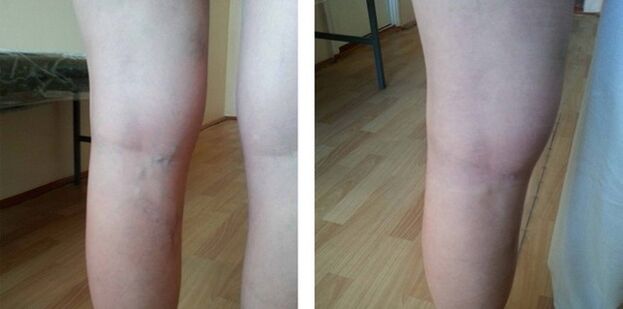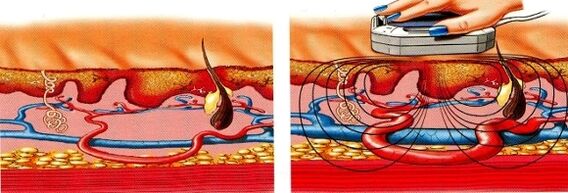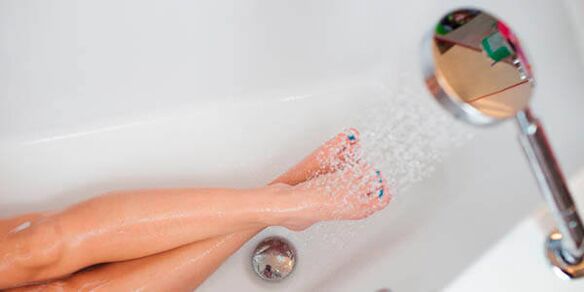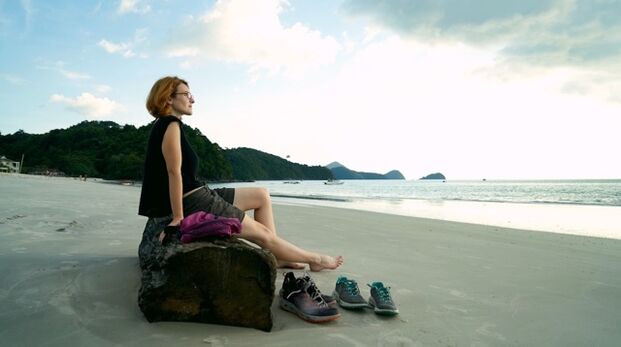Compliance with contraindications for varicose veins on the legs is the path to health.The patient will have to completely change his lifestyle, because...otherwise, the disease will continue to progress, which will lead to serious complications.Not every activity increases the symptoms of varicose veins.For example, walking is very useful because...it promotes the natural outflow of blood from the extremities.
What not to do with a certain degree of varicose veins
The attending physician is obliged to tell the patient what cannot be done for varicose veins of a particular degree, and what can be done.
It is noteworthy that with the initial symptoms of the disease, people prefer to keep their feet in basins with cold water, make lotions from some wild herbs, but not come to the hospital for examination.You shouldn't do that.
At the first symptoms of the disease, you should make an appointment with a therapist.After the examination, he will refer you to a phlebologist.
Initial stage
There are no special contraindications at this stage of the disease.If you have varicose veins, you can continue to play sports and take long walks in the fresh air.But you will have to give up uncomfortable clothes and shoes.You definitely need to visit a phlebologist.He will write a prescription for medications and help you choose the degree of compression of medical underwear.
Progressive varicose veins

Everything that cannot be done with varicose veins at the initial stage is strictly prohibited to be done with a progressive disease.In addition to existing restrictions, dietary recommendations are added.
The patient will have to completely reconsider his diet.If the patient is overweight, he is put on a forced diet.
Organ transplantation for varicose veins can be done if the main veins are not affected or the danger to the patient’s life is too high.
If your legs hurt a lot
Contraindications for varicose veins accompanied by severe pain include avoidance of strenuous exercise.Cool baths will help reduce discomfort.They can be done in the morning and evening.Physiotherapy for varicose veins of the lower extremities will be useful at the initial stage, but for actively progressing disease it is included in the list of contraindications.
Doctors recommend purchasing a special pillow for your legs.It can be used while resting at night.Elevating your legs will help facilitate the flow of blood from your extremities to your heart.A phlebologist can prescribe anti-inflammatory drugs if the pain is very severe.But when the condition improves, they must be abandoned, becausethey put a lot of strain on the liver.
If a vein bursts

It all depends on which vessel was damaged.
If a small vein bursts, the patient will get away with a spider vein, but if a large vessel is damaged, a large hematoma will appear on the surface of the skin, which in itself is very bad.
It is impossible to do pressotherapy for varicose veins in this condition.You need to apply an ice pack to the damaged area of the vessel, and after the pain goes away, go to see a doctor.
If your feet are itchy and swollen
Leg swelling is the first sign of varicose veins.They indicate that the blood flow is already disrupted and the tissues are not receiving enough nutrition.
In this condition, it is strictly forbidden to use diuretics and other drugs that help remove excess fluid from the body.The patient can use specialized cooling gels for varicose veins or moisturizing creams.
Of course, after detecting these symptoms, a person should make an appointment with a doctor.
If your legs go numb

Some grandmothers advise using a leg heating pad if this symptom occurs with varicose veins.This is strictly forbidden if you do not want to worsen your own condition.It is possible that the numbness of the limbs was caused by a blood clot that was stuck in the vessel.
By causing the vein to dilate, the patient can cause a blood clot to break off, which is a potentially life-threatening condition.Magnetotherapeutic treatment for varicose veins can relieve patients from numbness of the legs, becauseit helps to increase blood flow, but with a progressive disease it is contraindicated.
What can and cannot be done for varicose veins
If you have varicose veins, you should not expose your legs to prolonged exposure to high temperatures.Active mechanical impact on the legs will also lead to a negative effect.Allows you to do cold wraps, light massage and any other procedures that do not cause injury to the skin and blood vessels.
Tattoo
Is it possible to get a tattoo if you have varicose veins?Yes, if it is placed somewhere on the arm or shoulder blade, i.e.in an area not affected by the disease.Some women turn to salons asking whether it is possible to get a tattoo on varicose veins in order to cover the protruding vessels.A normal specialist will refer such clients to a phlebologist.
Before getting a tattoo for varicose veins, the patient should consult a doctor.If his desire comes from aesthetics, i.e.If he wants to close damaged vessels, it is easier to remove them with a laser or sclerosant.If the patient simply wants to have a certain pattern on his leg, then he still must first weigh all the risks.
Getting a tattoo for varicose veins is 90% likely to cause serious complications.
Compresses
It is believed that compresses are an excellent remedy for varicose veins.This statement is partly true.With their help you can get rid of swelling and other external manifestations of the disease.But applying compresses to trophic ulcers and allergic rashes is strictly prohibited.The natural products they contain will increase irritation.
Various types of hair removal
Removing excess hair on the legs is mostly a purely female problem.Standard hair removal methods for varicose veins are contraindicated.Pulling out excess hair with tweezers, hot wax or sugar paste will lead to an exacerbation of the disease.Women can get rid of excess hair on their legs using the following methods:
- laser hair removal;
- using specialized chemical creams;
- classic shaving;
- electrolysis (if the disease is at an early stage).
Other methods of hair removal will cause complications.Women will also have to stop wearing high heels.
Contrast shower and hydromassage

Contrast shower is considered one of the most useful procedures for varicose veins.It promotes natural irritation of the vascular walls.Thanks to the contrast shower, collagen production is normalized in patients and the density of veins increases.Hydromassage can be used to treat initial grade varicose veins.
Wraps
Contraindications for varicose veins in women include hot wraps.In general, all procedures that involve heating the legs and blood vessels will have to be excluded in case of varicose veins.
An increase in body temperature negatively affects the condition of the veins.Cold wraps, on the contrary, are useful for the initial stage of varicose veins.
It is advisable to use menthol or other components that cool the skin.
Abortion
Doctors often answer the question of whether it is possible to take OCs for varicose veins in the negative.But if you have an active sexual life and do not want to have a child, the use of estrogen contraceptives is the most optimal option, because

Abortion for varicose veins poses a threat to a woman’s life.It is especially dangerous to carry out this procedure if the patient has damage to the pelvic veins.With this form of the disease, women rarely manage to bear a child normally.
More often they experience spontaneous abortion.
Laparoscopy
Doctors cannot definitively answer the question of whether laparoscopy can be done for varicose veins.
Surgical intervention itself does not create any problems for the body if the disease affects only the veins of the legs close to the skin.
But if the main vessels are affected, it can be dangerous.On the other hand, laparoscopy is often used to diagnose pelvic varicose veins.
Mud therapy
This procedure helps to restore vascular tone in the initial stages of the disease.Mud therapy cannot be done if there are trophic ulcers on the body or the skin is damaged.This therapy is contraindicated for progressive varicose veins, becausedirt without any additional components dries the skin very much, and this is very harmful for problems with blood vessels.
Bath and sauna
You can use a scrub for varicose veins, but it should contain small particles that will not seriously injure the skin.
Such cosmetics are made from particles of raspberry seeds or ground rice.Sauna and steam baths are strictly contraindicated for patients with diagnosed varicose veins.
Again, it's all about the high temperature.It helps open pores, but also greatly harms the condition of blood vessels.
Soaring feet
It is strictly forbidden to warm your feet if you have varicose veins on your legs.Even if you have a cold, and your grandmother insists that a hot bath with mustard will help you recover quickly, you should not heat your extremities.
When the legs warm up, the blood vessels expand very strongly, and because...they already have an increased diameter, this leads to a deterioration in the general condition of the veins.
For varicose veins, patients can take therapeutic baths with a water temperature not exceeding 50 degrees Celsius.
Tan

You cannot visit a solarium if you have varicose veins.As to whether it is possible to sunbathe with varicose veins of the legs, doctors have different opinions.Some doctors claim that short-term exposure to sunlight benefits the body, but phlebologists claim that ultraviolet radiation strongly heats the legs, which is very harmful to the condition of the veins.
Taking potency medications for varicose veins
When asked whether it is possible to have sex with varicose veins under the influence of various drugs that enhance erection, all doctors will answer that it is not possible.Drugs for short-term relief of erectile dysfunction greatly increase blood pressure.This phenomenon poses a danger not only for people with heart disease, but also for those who suffer from various pathologies of the vascular system.
Contraindications to taking medications
For varicose veins, contraindications apply to many medications.First of all, patients should stop taking pills that cause high blood pressure.Medicines that constrict blood vessels should also be stopped.The group of prohibited drugs includes tablets that increase blood viscosity.
Physical activity
Exercises with a skipping rope for varicose veins will have to be excluded from the training program.This also includes athletics races.The problem is that these types of exercises place additional stress on the veins.
As a result, the vessels stretch both under the influence of blood flow and under the influence of gravitational forces.Physical exercises should be aimed at strengthening blood vessels.Sports walking, swimming, gymnastics, and non-power yoga are very useful for varicose veins.
Intensive training and football

People suffering from varicose veins will have to give up professional sports.Intense training accompanied by working with free weights is also a contraindication.
Football, volleyball and basketball can be practiced in the initial stages of the disease, but during training you should use compression garments or elastic bandages.
With further progression of the disease, these sports should be abandoned.
Nutrition rules
A proper diet for varicose veins helps to increase the effectiveness of medications taken.The patient should eat foods that strengthen the vascular walls.If necessary, nutrition becomes dietary if the patient has an excess body mass index or the presence of visceral fat.Doctors recommend consuming the following foods:
- nuts;
- fruits;
- lean meat;
- cereals containing carbohydrates and beneficial minerals;
- eggs;
- natural teas and juices.
Prohibited foods and drinks
Patients often do not know what they should not eat if they have varicose veins, so they practically do not change their diet.First of all, patients need to give up fat.Heavy varieties of meat, refined sugar, and fried foods will have to be completely excluded from the diet.Canned food also needs to be removed from the menu.Prohibited products include:
- all types of alcohol, becausealcohol helps dilate veins;
- black tea, strong coffee;
- seasonings;
- chicory (useful for hypertension, but because it dilates veins, it is dangerous for patients with varicose veins);
- sweets and soda, becauseThey consist of easily digestible carbohydrates and are therefore not suitable for overweight patients.
The specific list of contraindications depends on the person’s health status.Ideally, you can consume the entire product, but in small portions.Patients rarely adhere to this rule, so it is better to completely exclude from the diet foods and drinks that accelerate the development of varicose veins.
Folk remedies
First aid for varicose veins can be provided at home using folk remedies.Herbal components do not have a harmful effect on health, they improve the condition of the veins and relieve inflammation.
Let's consider effective folk remedies for varicose veins:
- A compress with chestnut has a good effect.It relieves pain and inflammation.To do this, you need to cut the black bread into slices and grease them with comfortable butter.Sprinkle the resulting pieces generously with pre-chopped horse chestnut fruits.
- For varicose veins, you can use a compress of burdock and horseradish, which is left overnight;
- Honey relieves pain and inflammation.
Varicose veins are a serious disease that requires a special approach.At this time, you should pay attention to your condition, nutrition and lifestyle.
There are also a number of procedures that should be abandoned or done less intensively - physical activity, hydromassage.But it’s better to completely avoid tanning and hair removal.
It is also worth considering that there are some illegal drugs that can worsen the condition.
Doctor's advice: what you need and can do for varicose veins

Varicose veins occur due to the loss of tone and elasticity in large and small veins.The veins greatly expand in diameter and form nodes.The disease is serious, unpleasant and ugly; we will tell you what can be done for varicose veins and what cannot be done further.
What you need and can do for varicose veins
Relief from varicose veins should begin with eliminating the causes that contribute to poor circulation in the extremities.
- When working sedentarily, you need to take a break every 1.5-2 hours.During this time, do some simple physical exercises.You can run 100–200 meters or at least rise on your toes 10–15 times.
- Before any physical activity, do not forget to bandage your legs with an elastic bandage or wear special medical stockings, tights or knee socks.Elastic stockings prevent further expansion of the veins and create resistance to venous stagnation.
- If you have varicose veins, try to buy comfortable shoes; your feet should rest in them and not be constrained by a narrow boot.
- If you have varicose veins, perform special physical exercises for your legs every day.The simplest exercise is to stand alternately on your heels and toes.For varicose veins, it is useful to do any exercises that involve raising your legs.
- Try to move more - this disease does not like movement.Walk up and down the stairs, use the elevator less often, walk more often, and sit in front of the TV and computer less.
- When you sit, try to put your legs higher.If you watch TV while sitting in a chair, place a low stool nearby and rest your feet comfortably on it.At night, place your feet on a small bolster or hard pillow.
- Swimming is beneficial for varicose veins.Swimming is considered the best prevention of varicose veins.The best rest for veins with varicose veins after a working day is a slow, calm walk and swimming in the pool.
- Try to stay in the pose with your legs raised above heart level for at least an hour a day.For example, you can lie on the bed and raise your legs up on the wall.
- In summer, try to spend your vacation on the river bank or by the sea.often walk barefoot on hard grass, sand or pebbles.Walking barefoot in sea water is especially useful for varicose veins.
Phlebologists who are involved in the development of diagnostic measures for varicose veins, their treatment and prevention of the disease strongly recommend giving your legs rest.At the slightest opportunity, try to stretch your legs, give them a rest and at the same time lift them higher, then the veins will always work like a clock!
What not to do with varicose veins

- If you have varicose veins, you cannot do any type of hair removal.Even the most gentle procedure can easily damage fragile vessels.Forget about wax strips, electric epilators and sugaring.
- If you have varicose veins, you need to protect your legs from aggressive influences, so avoid using scrubs that contain any sharp particles.
- You need to give up high-heeled shoes, health is more important than beauty.
- Sitting cross-legged with varicose veins is strictly prohibited.
- Do not use rough or hard washcloths.If you have varicose veins, do not massage your shins with rough brushes.
- Be very careful about anti-cellulite massage - it can increase the manifestation of venous insufficiency.Before deciding on the procedure, you should consult a phlebologist.
- Smoking is the number one enemy of varicose veins.The choice is simple: either smoke or live a full life and have healthy legs.
Any illness can be overcome, you should never give up, otherwise the disease will ruin your whole life.For varicose veins, nightly foot baths with sea or regular table salt are useful and necessary.Iodized salt is also suitable for procedures.
- To perform the procedure, fill the bath with water so that it reaches the middle of the calf.Dissolve one or two tablespoons of salt in water and walk in the bath for about five to ten minutes.The same baths with infusions of chamomile, oat straw, mint, sage and yarrow have a positive effect.
- Treats varicose veins and thrombophlebitis with a compress made from white cabbage leaves.Lightly beat the cabbage leaf and roll it with a rolling pin.Grease one side of the sheet with vegetable oil and apply this side to the diseased veins.Strengthen the sheet with a bandage and leave it for a day.The course of treatment is one month.
- For varicose veins, applications made from grated raw potatoes have a good effect.Wash the potatoes, peel them and grate them.Place the mixture on a cloth or gauze and apply to the affected veins.The duration of the procedure is 15 minutes or more.
- For severe pain in the legs, it is recommended to rub your legs with undiluted apple cider vinegar in the mornings and evenings.You can soak wipes in undiluted apple cider vinegar and wrap them around your feet.
Wrap the leg in a soft terry towel.Place your feet on a bolster or hard pillow and hold for about half an hour.
If you do such wraps for varicose veins every day for a month and a half, the pain should disappear.
Doctor's advice: what you need and can do for varicose veins.
- Varicose veins can be treated with fern.Grind fresh, freshly picked fern leaves into a paste.Mix 1/1 with sour milk and apply an even layer to areas with dilated veins.Treatment should be carried out for a maximum of 4 days, then take a break for several days.Such compresses can be repeated with a break of several days.
- It is recommended to regularly apply fresh tomato pulp to the veins affected by varicose veins.Cut a large and ripe tomato into thin slices and bandage it to the sore spots.Keep the compress for three hours.
- For varicose veins, you can and should do superficial self-massage.Carry out the massage with soapy hands; they should glide very well over the skin.
- For severe pain in inflamed veins, vodka tincture of horse chestnut flowers will help.Grind 50 grams of flowers into powder, pour in 1/2 liter of vodka and leave for several days.Rub the tincture into the veins very carefully, with light movements.
- Rubbing vodka tincture of Kalanchoe pinnate leaves into sore spots with varicose veins will have the same effect.Rinse fresh leaves with water, grind into a paste and pour in vodka in a ratio of 1/10.Leave in a dark place for three days, strain before use.Use for rubbing 2-3 times a day.
- For varicose veins, a compress of well-mashed red cabbage leaves softens and relieves inflammation.
- Tincture of celandine will help relieve blueness of the feet.Take 10 drops of tincture per tablespoon of milk three times a day before meals.
- Burdock or lilac leaves help get rid of blueness of the legs due to varicose veins.Mash fresh leaves in your hands and bandage them to your feet.
If you notice changes in the veins in your legs, try to reconsider and change your lifestyle.Go for walks more, play sports, limit your diet and avoid physical inactivity.
As the disease progresses, the help of a phlebologist is necessary.Genetic predisposition to the disease and other factors can be overcome.It is important not to be lazy, not to give up, to follow the doctor’s recommendations and not to forget basic recommendations.
Millions of people are familiar with the problem of varicose veins of the lower extremities first-hand.Heaviness in the legs, the appearance of edema and blue veins (vascular networks) barely noticeable at the first stage are serious reasons to be wary.
The development of the disease cannot be started - treatment of patients can continue for many years if they do not consult a doctor in a timely manner.Some treatment methods are based on taking measures available to everyone.
These include:
- Use of special gels and ointments. They are indeed capable of removing or reducing pain in the legs, but they are effective only if treatment is started at the first stage of varicose veins;
- The use of venotonics for varicose veins of the legs - drugs taken only as prescribed by a specialist. Unlike ointments, they act from the inside, producing an effect faster;
- Treatment with laser. It turns out to be effective in relation to “networks” and other signs of the initial stage of varicose veins;
- Treatment using ozone injected directly into the area of accumulation of “nets” on the legs. In this case, more than one procedure is required to alternately affect all enlarged vessels in the legs;
- The most “crude” method is surgical intervention (phlebectomy). The affected area where a blood clot may form is removed.
The appearance of signs of varicose veins: heaviness in the legs, characteristic “webs”, swelling – this is a reason to consult a doctor.We must not forget that it depends only on us whether we will be as mobile in old age or whether we will suffer from varicose veins at a relatively young age.






























